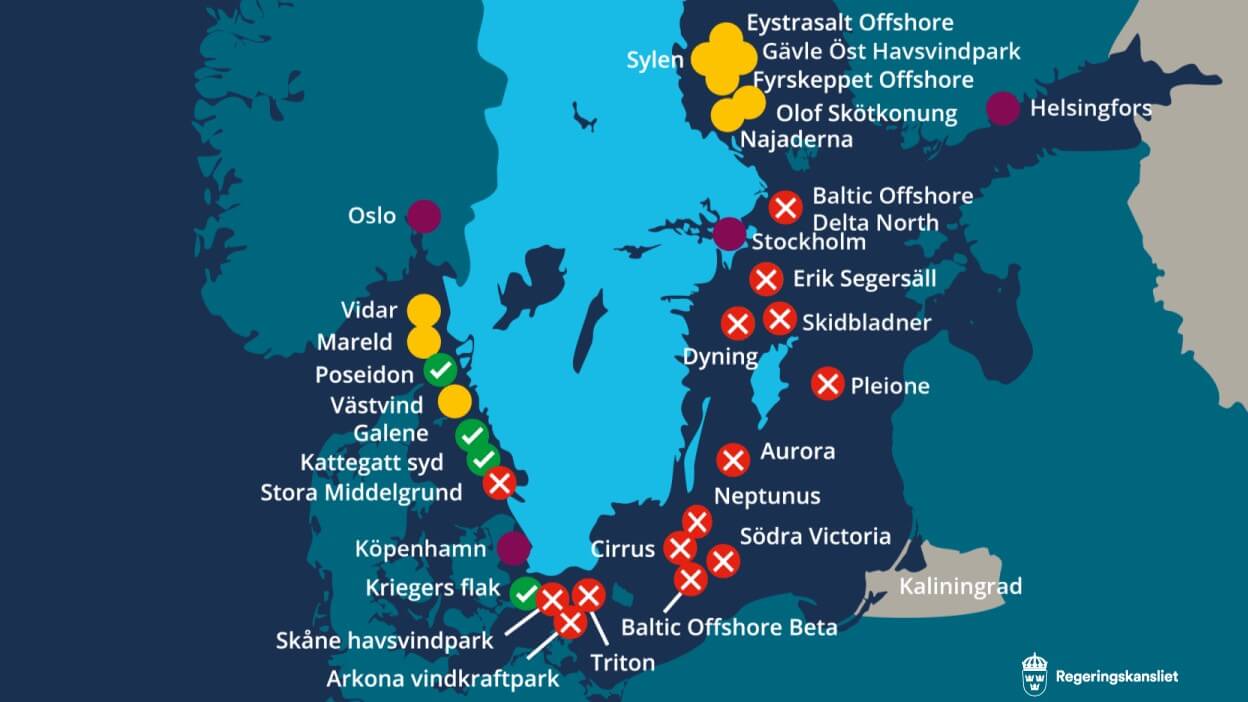UPDATED 1 Sept: The EI library in London is temporarily closed to the public, as a precautionary measure in light of the ongoing COVID-19 situation. The Knowledge Service will still be answering email queries via email , or via live chats during working hours (09:15-17:00 GMT). Our e-library is always open for members here: eLibrary , for full-text access to over 200 e-books and millions of articles. Thank you for your patience.
New Energy World™
New Energy World™ embraces the whole energy industry as it connects and converges to address the decarbonisation challenge. It covers progress being made across the industry, from the dynamics under way to reduce emissions in oil and gas, through improvements to the efficiency of energy conversion and use, to cutting-edge initiatives in renewable and low-carbon technologies.
Swedish government rejects 13 offshore wind projects over defense concerns
13/11/2024
News
In an unexpected move, the Swedish government has rejected applications for 13 offshore wind power projects in the Baltic Sea, citing defense concerns. The controversial decision halts projects totalling nearly 32 GW of potential installed power, equivalent to approximately 140 TWh of annual electricity production. Critics regard the announcement as a massive setback for renewable energy in the country, despite the government approving the Poseiden floating offshore wind project.
The 13 rejected offshore wind projects, proposed by Deep Wind Offshore, Eolus, Freja Offshore, Ørsted, OX2, RWE and Statkraft, would have been located in waters to the south and south-east of the country (see Map).
According to Climate and Environment Minister Romina Pourmokhtari, the government’s decision was based on the Swedish Armed Forces stating that the wind projects would lead to ‘unacceptable consequences for Sweden’s military defense’. Defense Minister Pål Jonson emphasised the importance of defense considerations given heightened security anxieties in the Baltic region following Russia’s incursion into Ukraine in early 2022, which led both Sweden and neighbouring Finland to join the NATO political and military alliance – Finland became a full member in April 2023 and Sweden in March 2024.
The project rejections drew immediate criticism, with Swedish wind association Svensk Vindenergi calling the decision ‘surprising’ and ‘problematic’, stating the government had effectively ‘closed an entire area to potential electricity production without a proper overall assessment of the opportunities that offshore wind power expansion entails’. Noting that Sweden currently uses some 130 TWh/y of electricity, the Association says the 13 rejected projects represent more than a year’s worth of electricity demand, in total. It also warns that some SKR550bn (€47bn) of private investment could now be lost.
European wind association WindEurope echoed these sentiments, saying the government’s decision represented ‘a serious blow to Sweden’s wider energy security targets’ and was ‘yet another setback for Sweden’s offshore wind ambitions’, undermining investors’ confidence and putting Sweden’s industrial competitiveness at risk.
‘Yet again Sweden is bottom of the class on offshore wind,’ comments Giles Dickson, WindEurope CEO. ‘The Swedish government has been unhelpful on offshore wind for many years. But a plain ban on offshore wind development in large parts of the Baltic Sea is unheard of. This makes no sense, not least when all the other countries around the Baltic Sea want to build more offshore wind and are progressing well on it.’
According to WindEurope, Sweden currently has only 0.2 GW of offshore wind farms, a fraction of the 2.6 GW that neighbouring Denmark has.
Claiming that the military in Sweden ‘has been blocking offshore wind projects for years’, WindEurope highlights that the seven other governments around the Baltic Sea have ‘chosen a totally different approach’, establishing ‘joint formats between the offshore wind industry and the military to enhance understanding and exchange and to develop solutions that work for both partners’. For example, offshore wind development in Poland is seen as a way to enhance military surveillance capabilities, with radar and sonar systems placed in offshore wind farms used to provide data to improve military operations and ensure security.
WindEurope is currently working with NATO and European Defence Agency (EDA) to address the concerns raised by the Swedish government and its military. This includes the ‘Symbiosis’ project which aims to support the coexistence of offshore renewable energy projects and defence operations in European maritime spaces.
‘European governments mustn’t fall for the Russian intimidation and interference with energy policies. Offshore wind means more energy security and less dependence on Russian energy imports. Russia wants the EU’s successful transition to cheap and local renewables to fail. But let’s be clear: offshore wind can coexist happily with military activity,’ said WindEurope’s Dickson.
WindEurope also sees the Swedish approach to offshore wind development, the so-called ‘open-door’ system, as a contributing factor to the large number of cancelled projects. In this system, developers initiate projects without prior alignment with military, shipping, or environmental interests, often leading to conflicts. Only Italy and Sweden use this approach, while most EU countries adopt a centralised system where government agencies pre-select and develop offshore sites, aiming to minimise adverse effects. In this approach governments usually also lead on the grid connection planning with national transmission system operators. The sites are then tendered to offshore wind developers to undertake the remaining steps of project development.
A positive note
Despite halting the proposed 13 offshore wind projects in the Baltic Sea, the Swedish government says it still wants to develop wind and solar energy. As evidence of this, it also announced that it had given the green light for the Poseidon floating offshore wind farm in southern Skagerrak (leading to the North Sea) on the west coast of Sweden.
Being developed by Vattenfall and Zephyr Vind, the 1,400 MW project is expected to deliver 5.5 TWh/y. The approval calls for the wind farm to be completed no later than 2034.

Map showing location of the 13 offshore wind projects rejected by the Swedish government (red crosses), those approved (green ticks), and those currently under consideration (yellow circles)
Source: The Swedish Government
